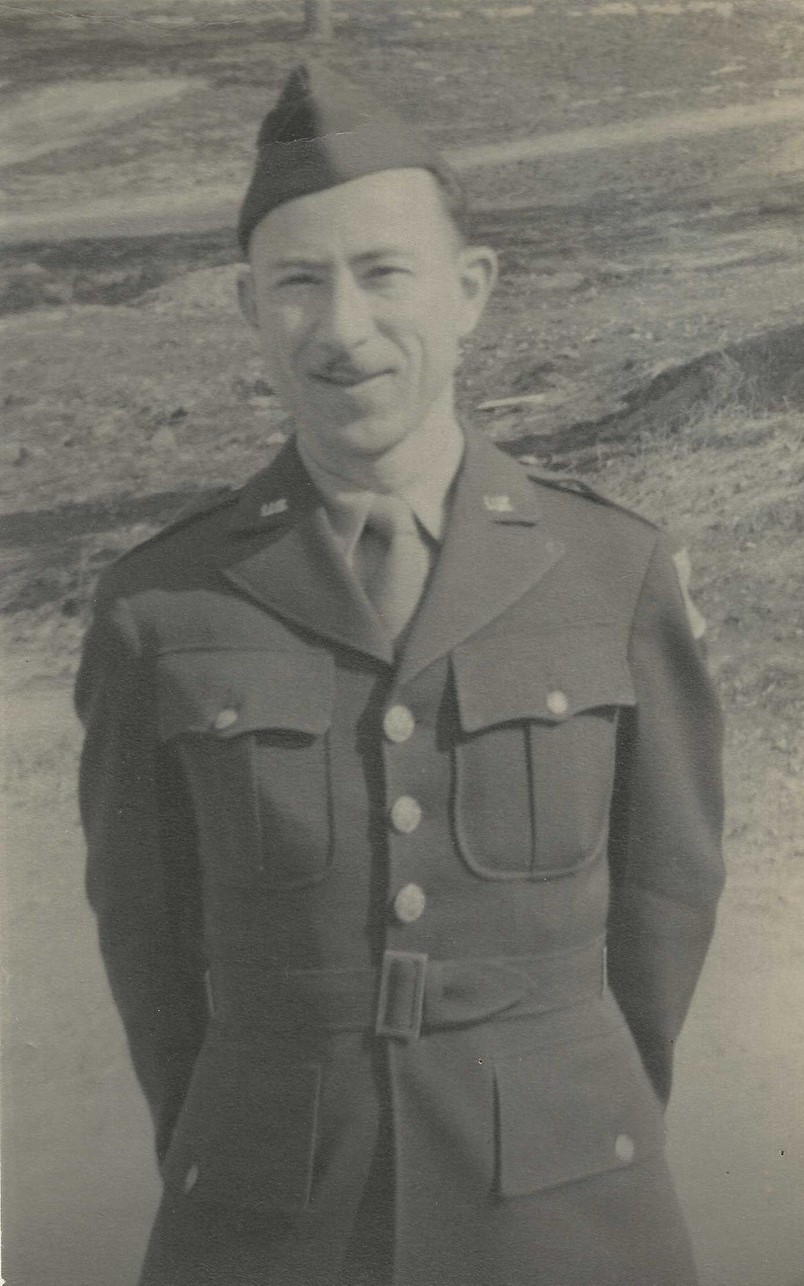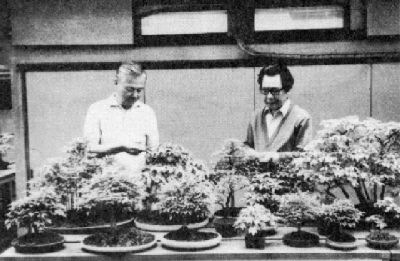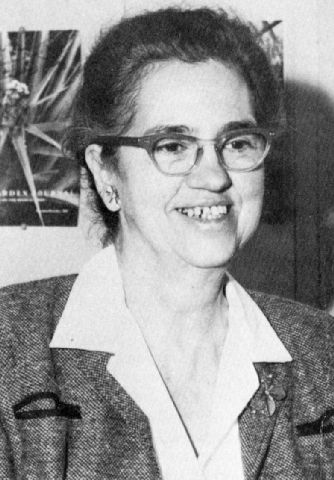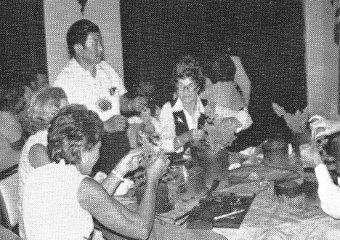| 11 |
|
| 12 |
1909 -- Yoshio "Bob" Kataoka was born in Hiroshima, Japan. [He would go to the United States at age 17 and eventually
move to Colorado where he would be an influence on the bonsai community there.]
"Yoshio Bob Kataoka,"
http://www.findagrave.com/cgi-bin/fg.cgi?page=gr&GSln=Kataoka&GSfn=Yoshio&GSby=1909&GSbyrel=in&GSdy=1986&GSdyrel=in&GSst=7&GScntry=4&GSob=n&GRid=47394380&df=all&)
SEE ALSO: Feb 24
1959 -- Yuji Yoshimura, 37 years old and in the U.S. barely six weeks with over one ton of teaching and demonstrating material, gave his first course at the Brooklyn Botanic Garden, "Bonsai Study & Practice." The very successful course -- one of the orginal students was Jerald P. Stowell -- was one of many which Yoshimura-san taught on many levels during the spring and autumn of that year while on a C. Stuart Gager fellowship grant. ("Yuji Yoshimura, A Memorial Tribute To A Bonsai Master & Pioneer" by William N. Valavanis, International Bonsai, IBA, 1998/No. 1, pg. 34) SEE ALSO: Feb 27, Apr 23, Jul 17, Dec 24 1999 -- Giovanna Halford-MacLeod, co-author with Yuji Yoshimura of the 1957 work The Japanese Art of Miniature Trees and Landscapes, died in Stornoway, Isle of Lewis, Scotland at age 84, some months short of her and her husband's diamond wedding. [Husband Aubrey would die in Perth, Scotland in August 2000 at age 85.] (personal e-mail from Mary-Bess Halford-Staffel to RJB 23 Nov 2010; "Aubrey Halford-MacLeod," http://www.telegraph.co.uk/news/obituaries/1353686/Aubrey-Halford-MacLeod.html) SEE ALSO: Nov 2 |
| 13 |
|
| 14 | 1905 -- Takeo Fukuda was born in Gunma Prefecture, Japan. [He would serve as Minister of Foreign Affairs, Minister of Finance, and Minister of Agriculture, Forestry and Fisheries before becoming Japanese Prime Minister from 1976-1978. In 1983 he would found the "Interactive Council" (OB Summit) of elder statesmen together with former West German Chancellor Helmut Schmidt and others. In 1988 he would succeed Nobusuke Kishi, also a former prime minister, as president of the Nippon Bonsai Association. In 1990, he would be elected president of the World Bonsai Friendship Federation.] ("Profile", Tsukiyama, Ted T. (ed.) Bonsai of the World, Book I (Japan: World Bonsai Friendship Federation, 1993), pg. 2) SEE ALSO: Jul 5, Oct 20 |
| 15 |
1917 -- John R. Mercier was born in Topeka, Kansas. [By 1930 his family would be
living in Texas. He would work for the military his entire life, being in Japan during the Occupation.
John would be present at and record on November 24, 1945 what would be a little-recognized but ultimately major
turning point for the direction and fate of post-war Japanese bonsai. John would die in September 1998, in
Austin, TX at the age of 81 from complications of Alzheimer's Disease. His daughter would remember that "He
and my mother loved rocks and plants their entire lives."]
John R. Mercier
(Emails from Helen E Mercier Davis to RJB, 05/23 and 5/24/22;
"John Mercier,"
Family Search.org) SEE ALSO: Jul 7, Nov 24
(Photo courtesy of daughter Helen E Mercier Davis) 1924 -- Tom T. Yamamoto was born in Honolulu, HA, the youngest of six children. [He would graduate from McKinley H.S. (Honolulu) and enter the military service two years later in 1944. When young he would always be interested in horticulture. His first exposure to bonsai would come in 1946 when he was a member of the U.S. Occupation Forces in Japan. He would be fortunate to be stationed in Japan on and off for eleven years. During this time he would become very interested in bonsai and start to learn this fascinating art. One unfortunate thing about being in the service is that whenever you are transferred, you can't take the bonsai with you. Upon retirement in 1965, a veteran of WWII, Korea, and Vietnam, Tom would decide to go back to Japan to learn more about bonsai. When he would start his training under Mr. Kawamoto and other experts, he had no idea that one day he too would be teaching this art. After studying for several years, he would be compelled to start teaching because there were no English-speaking teachers around. Some of his students would be Ambassadors from other countries and their wives. There were also many people working at the Embassies and other foreigners living temporarily in Japan. Tom would enjoy sharing his Bonsai-Saikei knowledge with others. His other love would be breeding and showing Yorkshire Terriers. He would be on the Board of Directors of the Nippon Yorkshire Terrier Club and also a judge at those shows. His two interests would keep him busy throughout the year.] 
"Guest artists Mr. Toshio Kawamoto (right) and Mr. Tom Yamamoto (left) will be appearing
("I.B.C. '78," Bonsai Magazine, BCI, Vol. XVII, No. 1, Jan./Feb. 1978, pg. 12 with b&w
photo of him assisting Mr. Kawamoto in a workshop in Kansas City in 1972)
at IBC Portland July 19-23..." (Bonsai Magazine, BCI, April 1978, pg. 981) 1989 -- A most elegant naming ceremony for seven outstanding bonsai was conducted at the Japanese American Community Center in Los Angeles, CA by the Bei Koku Bonsai Meigo Kai, a panel of distinguished bonsai experts. The honored designers were Marybel Balendonck, Harry Hirao, Mas Moriguchi, John Y. Naka, Ben Oki, Richard Ota, and George Yamaguchi. The presentations were made by the Honorable Hiromoto Seki, Consul General of Japan. ("Bei Koku Bonsai Meigo Kai Naming Ceremony," Bonsai Magazine, BCI, Vol. XXVIII, No. 2, March/April 1989, pp. 16-17) SEE ALSO: Jan 1 |
| 16 |
2006 -- Frank Okamura, retired bonsai master from the Brooklyn Botanic Garden, died at age 94.
(Obituary by Botanic Gardens Conservation International, Jan 18, 2006,
http://www.bgci.org/worldwide/news/0157/)
SEE ALSO: May 5
2017 -- Bonsai master Rudi Adam died at his home in South Africa. (He was born in Vienna, Austria in 1944. His fascination began when as a schoolboy there he would pass by a furniture store every day, seeing a dwarf tree on display in the front window. "It never changed, and I asked what it was and they told me, a bonsai. I liked it" -- even though that Hinoki Cypress would have cost a year's salary. He eventually came to South Africa and at first tried to grow tropical fish and succulents. After the second time that his maid killed all his several thousand fish by unplugging the electricity supply, he turned his attention to bonsai. "I was getting on my wife Patricia's nerves," he said. She then took him to the first spring Cape Bonsai Kai show at Kirstenbosch National Botanical Garden in 1970. Half-way through the display Rudi joined the club which had broken away from the Bonsai Society of South Africa. He became one of the first paid-up members of the club, of which there were six members at the time. His first collected tree was a pine that he took to Bernard Coetzee, founder of most Cape-based clubs, for help with the design of the tree. He wanted to plant his pine on a rock, and it took a whole Saturday to prepare it. "I told my teacher -- this is the last one I do." Famous last words. Rudi started a "place of learning" as well as a "nursery" in 1976. At first its main objective was to teach others the art of bonsai and then to find an outlet for the trees created by the class and during workshop sessions. It was tough to learn in those days, since books were a rare commodity, but after saving some money the Cape Bonsai Kai was the first club to import the well-known American bonsai master John Naka. John first demonstrated in South Africa in October 1980. His enthusiasm and wide-range of knowledge of bonsai as well as tree species started to catapult the West to the forefront of the art, outside of the Japanese community. Rudi's 24-page Basic Bonsai Workbook was published in 1983. He then visited the first World Bonsai Convention in Japan six years later, and his travels through that lovely country made it possible for him to understand the history and thoughts behind the art of bonsai, martial arts, ikebana, suiseki, and other Japanese forms practiced. To compare the different schools within bonsai Patricia and Rudi also travelled to Europe, Hong Kong, Taiwan and over most of Mainland China, viewing bonsai, gardens, and cultural events. Rudi's more mature 167-page book Bonsai in South Africa was published in 1992 with a Foreword by John Naka. Apart from three years, Rudi lectured and was one of the main speakers at the national conventions held in the various centres. He continued to lecture to the local clubs -- where in most of them he was an honorary member. His support to the national as well as the local associations was without question. His effort to conciliate the varying parties and his willingness to supply material for a variety of competitions showed his commitment. He trained between 80 and 100 new bonsai enthusiasts, per season, plus some 30 advanced students. Realising that the bonsai world cannot rely only on the advanced, he took four talented and enthusiastic young members from various clubs under his wing to ensure the forward movement of the art. Rudi's bonsai collection had about 150 trees in his garden adjacent to his nursery at the Olive Grove Bonsai Centre. The move to this smallholding in Langeberg Ridge, Durbanville, Cape Town in 1997 provided another service to the bonsai community in the form of large-bag as well as ground-grown bonsai starter plants. Apart from Rudi and his wife, there was also a trained horticulturist (Jan-Jurie), two groundsmen as staff and some ducks as snail hunters. Possibly the most famous tree in South Africa is a large 150-year-old wild olive there. He "stole" it, that is, dug it up and had been working on it for two decades. As Rudi described it when he had the tree on a turntable for one of the many guests to his nursery, "It has three fronts. This is the Japanese front; it must be friendly, no branches are poking out at you and the focal point is the middle of the tree. (A slight turn.) This is the Chinese front; see the family -- the grandparents below, the children and the grandchildren on top. (Another turn.) The European front is like a flower arrangement." "You're in charge, and while the tree dictates to you, you need to take [the tree's] ability into account. The tree has something to say, you have to understand each species." Rudi's final book Master Bonsai, a Practical and Inspirational Guide was published in 2013. Since the year 2000 alone he had accumulated some 90 awards for his trees at various exhibitions. His trees had also been used as material in the bonsai books of many other authors, both local and foreign.) (Per Facebook Message from Caroll Dewar Hermann to RJB on Jan. 18; "Bonsai -- Rudi Adam," with pictures of a number of his trees, http://www.stonelantern.co.za/bonsai-in-the-western-cape-south-africa-3/bonsai-rudi-adam/ ; "About the Nursery," Olive Grove Bonsai Nursery, http://www.bonsaiolivegrove.co.za/ ; "About Rudi," http://www.bonsaiolivegrove.co.za/about-rudi ; Viall, Jeanne, "Gallery: The slow art of bonsai," 10 December 2013, http://www.iol.co.za/lifestyle/home-garden/garden/gallery-the-slow-art-of-bonsai-1619983 ; "Rudi Adam," http://www.goodreads.com/author/show/7375983.Rudi_Adam ; "Rudi Adam," http://www.metzpress.co.za/authors/rudi-adam.) SEE ALSO: Jan 25, Apr 8 |
| 17 |
1920 -- John L. Creech was born in Woonsocket, RI. [He would go on to have a
distinguished military career and be a professional horticulturist. As the third Director of the U.S.
National Arboretum in Washington, D.C., he would go on to shepherd what became the Japanese gift of bonsai
and suiseki to the U.S for its Bicentennial, the start of the U.S. Bonsai and Penjing Museum.]
(SSN Master File by Number) SEE
ALSO: Aug 7
1978 -- Editor of the American Bonsai Society Bonsai Journal Dorothy Ebel Hansell died unexpectedly. (When she was a young woman in her twenties, she inherited from her father the publishing and editorial responsibilities of The Gardeners' Chronicle of America. At the same time, she was appointed executive secretary of the National Association of Gardeners. During the next 50 years she was a founding member, director, editor, and/or officer of many plant societies, including the American Rock Garden Society, the American Horticultural Society, the American Association of Botanical Gardens and Arboreta, the Holly Society of America, the American Iris Society, the Garden Writers Association of America, and the New York Botanical Garden. Beginning in 1968, within a year of its founding, the American Bonsai Society was fortunate to have her as a consulting editor and then editor of its quarterly.) 
|
| 18 |
|
| 19 |
1940 - Andrew Nicholas Lenz was born. [He would go on to become an
iconic bonsai artist and teacher, among other career paths].
(Abel Lenz's April 14, 2022 FB posting of
Memorial Notice.)
SEE ALSO: Apr 8, Oct 26
2001 -- Bonsai master Ken Sugimoto died in Palo Alto, CA a few months shy of his 94th birthday. (RJB phone call to Tak Sugimoto on Aug. 16, 2005) SEE ALSO: Apr 1 |
| 20 |
1916 -- Sam Shigeo Nakano was born in Florin, CA, seven miles outside of Sacramento.
[His father was a farmer growing grapes and strawberries. At age 17, Sam would be a foreman managing a packing shed.
He would later sell strawberries as a jobber to wholesale packing houses. In his early 20s he would operate his own
fruit and vegetable store in Sacramento. In 1942, Sam would be sent to the Manzanar Relocation Camp. There he
would meet, marry and produce a first child, a boy, with Agnes Ikio Yano. From the camp they would go to Pennsylvania
for the duration of the war and continue the family by adding three girls. Back in California, Sam would help operate
a family-owned company that dealt in crates and boxes. He would be introduced to bonsai by an old man who worked in
the crate yard. The old man would take Sam to see his own collection of trees and those of several others.
Soon Sam would be on his way with a black pine and seedling olive bonsai. In his mid-40s, Sam would leave the crate
business and take up gardening, a brother who had a gardening route would show him the mechanics of the trade. Within
a year he would have a gardening route of his own. Not only would Sam be older than most new gardeners, he would be
more curious about horticulture. Sam would take all the gardening courses given by the Los Angeles school system.
Then he would take the horticultural courses at the University of California at Los Angeles. Additionally, Sam would
take courses through the Southern California Gardeners Federation, a group of 22 gardeners association. He would
particularly recall an instructor who came from Japan to teach the construction of the Japanese garden, hills and rocks.
By the mid-1970s Sam would be giving lectures for the Federation. [Now, in 1923 Kaz Yoneda would be born in Utah. He would arrive in Los Angeles the year before WWII began and would return at war's end. He would settle in the southwest section of the city and start a gradening business. One day in the 1960s, one of Kaz's customers would approach him with a small bonsai and ask if he could help him with the tree. Without training in that gardening art Kaz could not, but he would have heard about a bonsai class that a man named John Naka would be offering at the Southwest Gardeners Association Hall and Kaz would decide to give it a try. There he would meet Sam Nakano who'd also have signed-up as a student and the two would remain friends until Sam's death some three decades later. Sam and Kaz would begin teaching bonsai in the early 1970s and would work together since. On many occasions Sam would narrate while Kaz would handle the demonstration. In July 1974 Sam would be the Social Chairman of the California Bonsai Society Convention in Pasadena, CA where the joint Bonsai Clubs International / American Bonsai Society Convention would be concurrently held and where more than 500 enthusiasts would attend from the U.S., Japan, Australia, and Canada. For years Sam and Kaz would be heavily involved in the administrative end of bonsai. Sam would be President of the California Bonsai Society in 1989 and Kaz would follow him in that office. In 1989 Sam would also become involved as a volunteer bonsai instructor at the Seinan Senior Citizen Center. (When Sam passed away, Kaz would step in and continue his place.) For many years, both Sam and Kaz would teach bonsai together at the Yamaguchi Bonsai Nursery.] 
"Sam Nakano discussing the health of the foliage [at the 1974 Convention]."
(Donovan, Earl H. "The Nakano Window," Bonsai Magazine, BCI, Vol. XIII, No. 6, July-August, 1974, pp. 24-25;
"The Patio," International Bonsai Digest Presents Bonsai Gems, Fall 1974, pp. 81, 85, 88; ; Yeager, Ray
"Bonsai in Los Angeles: A History of the Early Years, 1933 to 1975, Part I," Bonsai, BCI, October/November/December
2005, pg. 41.)
SEE ALSO: Aug 7.
(International Bonsai Digest Presents Bonsai Gems, Fall 1974, pg. 85) 2019 -- Mary Ruth (née Sexton) Wilkinson passed away peacefully after a long battle with illness at the Bupa Bendigo Nursing Home in Bendigo, about 131 km/81 miles northwest of Melbourne, Victoria, Australia. A much loved and loving wife, mother, grandmother, and an amazing cook, she was also a bonsai artist of reknown, whose knowledge and skills will be greatly missed. A founding member of the Bendigo Bonsai Club in 1978, she was "heart and soul" of the club. A highly talented yet humble artist who was always supported by her husband Eric, Mary was one of the very first to grow Australian Natives as bonsai. Her trees were seen at the National Arboretum and at many exhibitions in Victoria. Very gentle and generous, with a quiet streak of steel right down the middle, she thought to make her trees "natural" -- but more interesting -- heightened nature, if you will. ("Tribute to Mary Wilkinson," thread in ausbonsai.com forum, January 27, 2019; "Mary Ruth WILKINSON," Legacy.com obituaries; About Us," Bendigo Bonsai Club, which gives founding date as 1978, cf. 1991 in the ausbonsai.com thread.) SEE ALSO: Jun 2 2022 -- Gianfranco Giorgi, a pioneer of bonsai in Italy, passed away. (Born in 1931, his passion with bonsai dates back to the 1960s. He actively promoted the formation of the Italian Bonsai Association (AIB) in 1974 and served as its president. In April 1980 he was called to represent Italy at the International Bonsai convention in Osaka, Japan. He authored Bonsai come e perche in 1981, and then Tutto bonsai in 1990. This was translated into English that same year as Simon & Schuster's Guide to Bonsai, edited by Victoria Jahn of the Brooklyn Botanic Garden. The next year is was translated into French as Les Bonsaï and then into Spanish in 1992 as Guía del bonsai. Another Italian work, Bonsai, was also published in 1990, as well as The Macdonald encyclopedia of bonsai in English A French edition, Le guide vert du bonsaï, was published in 2001. Giorgi's work with photographer Enzo Arnone, and Van Huan Tran and Tich Luom Van, Ky thuat trong bonsai was published in Vietnamese in 2003. Several editions of his various books saw print. (Giorgi participated in the BCI New Orleans Convention in 1985. That same year, the Florence-based Associazione Toscana Amatori Bonsai e Suiseki was co-founded Giorgi, Boni Elio, Lorenzo Agnoletti, and Umberto Margiacchi. This was one of the very first on the national scene and certainly the first also in the continent to indicate suiseki as part of the initials. Giorgi served as president. Giorgi's student Antonio Ricchiari wrote Manuale del Bonsai in 1987 with an introduction by his teacher. In September 1995 AIB (Italian Bonsai Association), ABI (Italian Bonsai Association) and ABAN (Bonsai Art and Nature Association) with their respective presidents, Gianfranco Giorgi, Luigi Crespi and Giuseppe Volonterio met to sign the deed of incorporation of UBI (Unione Bonsaisti Italiani). Since 2007 Francesco Santini has curated Giorgi's private collection of bonsai, among other.) (FB post by Francesco Santini, 20 Jan 2022, https://www.facebook.com/francesco.santini.31/posts/10227726896701447; Scarfuri, DiCarlo Associazione Toscana Amatori Bonsai e Suiseki (A.T.A.B.S.), 30 March 2018; A.I.A.S., http://www.aias-suiseki.it/en/taxonomy/term/66; "Gruppo Bonsaisti Medio Valdarno," https://www.bonsaistimediovaldarno.it/storia-del-club.html; "Santini Francesco," https://www.collegioibs.it/elenco-istruttori/istruttorebonsai/19.html; Francesco Santini 24 Jan 2022 FB Messengers to RJB to give birth year and correct minor spelling/translation error) SEE ALSO: Nov 7, Nov 12 |